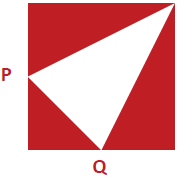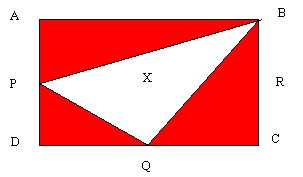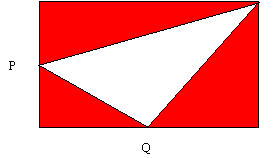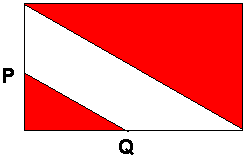This problem solving activity has a geometry focus.

She took a red square.
She then put a white triangular piece of material over the red square.
Her working sketch is shown here.
If P and Q are the midpoints of the original square, what fraction of the square did the white flag cover?
- Apply the angle properties of squares, rectangles and triangles.
- Use fractions to express the relationships between the areas of rectangles, squares and triangles.
- Devise and use problem solving strategies to explore situations mathematically (be systematic).
In order to find the area of the white piece of material it is necessary to break up the square into different smaller rectangles and square and compare these to the original square. This is the main problem solving strategy here and is a common feature of finding complicated areas. The idea is used again in Bill’s Badge, Measurement, Level 5.
The Problem
Flip made a flag for her boat. She took a red square. She then put a white triangular piece of material over the red square. Her working sketch is shown here.
If P and Q are the midpoints of the original square, what fraction of the square did the white flag cover?
Teaching Sequence
Introduce the problem by looking at the country flags. Ask the students to make "mathematical" statements about them. Ask the students to estimate the fractional relationships between the different parts of the flags.



Bahamas
Columbia
Kuwait
- Pose the problem to the class.
- Ask the students to use rulers to construct the flag in the problem.
- As they work on the construction, circulate asking questions that focus their thinking on the shapes that can be identified in the construction.
What shapes can you "see" in your construction?
What type of triangle is it? How do you know? - Once the constructions are complete, ask questions that focus on the regions of the flag and their respective areas.
How are you working out the areas when you haven’t been given any measurements?
What can you tell me about the line PB ? (side of triangle BPQ, diagonal of rectangle ABRP)?
What can you tell me about the triangle PDQ? How many triangles of this size would make up the square?
Why do you think that? - Share solutions
Extension
Suppose Flip’s original red square was a rectangle. Could she produce a white triangular piece that was 5/8 of the original rectangle?
Can she do this using some other shape?
Solution

In the rectangle ABRP, PB is a diagonal. Hence area of triangle APB = area of triangle PBR. Since rectangle ABPR is 1/2 of square, the area of triangle APB is 1/4 of square.
Similarly the area of triangle QBC is 1/4 square of square. Now triangle PDQ is 1/2 of area of square PXQD. This square is 1/4 of the original square. Hence triangle PDQ has area 1/8 of square.
So the white flag covers 1 - 1/4 - 1/4 - 1/8 = 1 - 5/8 = 3/8.
Solution to the Extension
The same calculations show that the white piece below has area 3/8 of the rectangle. Here P, Q are midpoints of the appropriate sides.

One other possible answer is shown below. Here P and Q are again midpoints.
The possibilities are probably endless.
